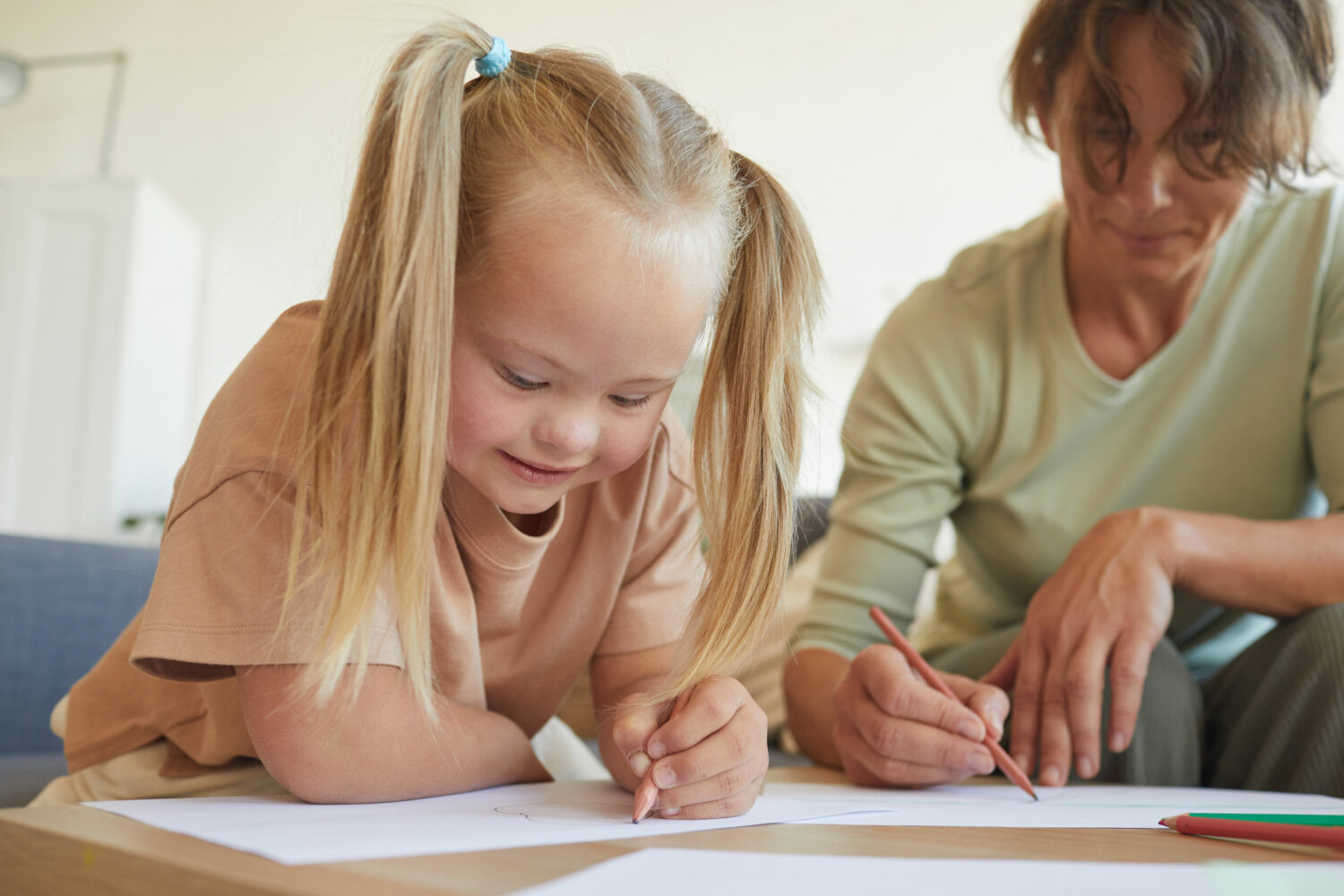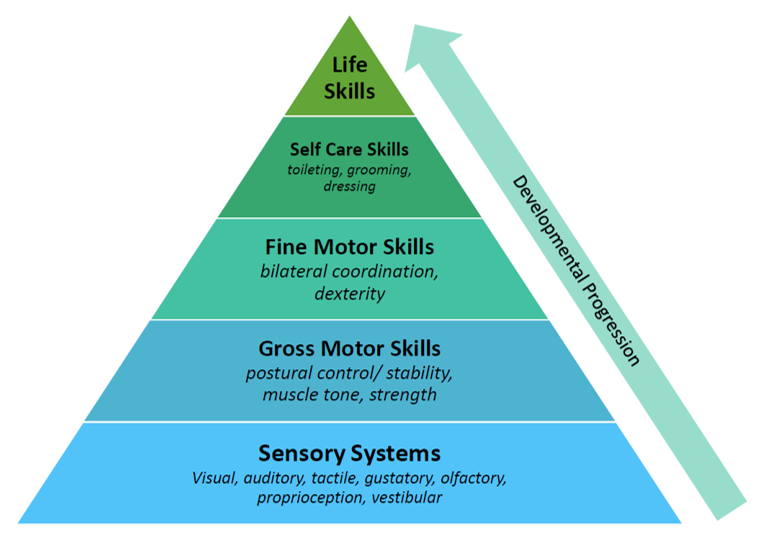Ready to Start

Preparing for Kindergarten Success
By Hina Mahmood, M.OT; Riley Rosebush, RSLP; Sara Peralta, BCBA; Danielle McKinney; Jeni Carcamo
Reprinted from 3.21: Canada’s Down Syndrome Magazine (Issue #12: The Back to School Issue). Click here to download the full magazine.
Starting school can be both an exciting and daunting experience for any family, and all the more so when the student has Down syndrome. School is a new adventure, and like any adventure, it goes best when we are prepared. The transition to kindergarten is most successful when it is thoughtfully planned out over the entire pre-kindergarten year.
The Down Syndrome Resource Foundation recently launched Kinder Kick-Off, a kindergarten readiness program, to equip students and families entering this new stage of life. Kinder Kick-Off is a collaborative effort spanning DSRF’s various disciplines with coaching from occupational therapists, speech language pathologists, behavioural consultants, and teachers. Together, they assess the school readiness of students in the areas of classroom basics, literacy basics, and life skills, and provide strategies for each of these spheres.
Below, the team provides their best advice for preparing your child with Down syndrome to get their school career off to a great start.
Physical Skills
Success in the classroom setting is achieved when there is a balance between the person, the environment, and the occupation (the task). Keeping in mind the person with Down syndrome, how they learn, what motivates them, and how they best function are all components that need to be considered.
In many cases, simple environmental adaptations can enable students to participate in all school activities. Students with Down syndrome may require supported seating in the classroom, adapted equipment at their desk, a safe and accessible toileting setup, or a plan for safe feeding strategies. They may also need various tasks and activities to be adapted to create the just-right-challenge and promote independence. Occupational therapists can assist with all of the above.
Success in kindergarten depends on building upon foundational skills. As the diagram below illustrates, students with Down syndrome first require support in establishing a strong sensory foundation. The classroom environment can be overstimulating, so ensuring they have the right tools to navigate that space is important.

Once the sensory piece is in place, students can then start to work on developing and improving their gross motor skills. Due to low tone, students with Down syndrome require more work to activate their muscles to walk, run, and stay seated at a table.
As the gross motor stage is emerging, fine motor skills can be introduced. A strong base of support is required before fine motor movements can be executed. Hand strength, dexterity, and grasp are all areas that can be targeted by OTs.
Finally, with these foundations in place, students can become more proficient in their self-care skills, such as feeding, dressing, and toileting. Whenever a new skill is being taught, it is important to remember that every skill has its own set of basic steps. Never skip the basics!
Keep in mind, these skills don’t all have to be in place before starting kindergarten. That first year of school is a great opportunity to learn new skills and strengthen existing abilities.
Speech and Language
There is a lot we can do for kids before school starts to help them communicate successfully in kindergarten. Many children with Down syndrome need support to understand information and follow directions in a busy classroom environment, and most children with Down syndrome need extra support to express themselves to others clearly.
Providing visuals can help children understand, process, and remember information and directions. Classrooms are busy and distracting places, and well-used visuals can help children feel more confident in tackling classroom tasks with greater independence. Visuals can be anything you can see, including objects, photos, picture symbols, signs, or demonstrations.
Consider how you will help your child express themselves to everyone they will meet at school. Many children will benefit from a form of Augmentative and Alternative Communication (AAC) that can help them say what they’re thinking and get their needs met. Research shows that AAC doesn’t limit verbal speech, and in fact often helps develop verbal language skills while allowing children to communicate successfully with others.
Along with your SLP, practice giving your child an effective way to communicate that they’re all done with something, that they need a break, that they want more of something, and that they need help. Mastering all these important communication functions will help your child participate and succeed when they hit the classroom.
Behaviour
School is a new environment for kindergarten students, full of new routines and expectations. This presents opportunities to learn positive new behaviours, many of which can be practiced in the years leading up to school entry to smooth the transition.
Although learning looks different for everyone, one thing we know is that children learn through play. Many kindergarten classrooms incorporate play into their daily schedules. At home, parents can use play as a learning moment by playing in a way that is child-led, focusing on what the child is highly motivated by and allowing this to be a positive and engaging interaction for both parent and child. During child-led play, we can focus on creating a time where there are no obvious instructions or expectations from the child, except to have fun interacting with the parent.
Sometimes as parents, it is tempting to use play as a teaching opportunity wherein we want our little ones to practice the things we know they can do or that we want them to improve. This leads us to ask many questions or instruct the child to play a certain way. Conversely, when we focus on child-led play, playing does not become a task for the child.
Think about how it may feel for you to be engaging in your favourite hobby, only to have someone constantly telling you to do it differently or peppering you with questions. Not fun! Instead, get down on the floor and join in the fun, focusing on your child’s preferred way of playing and interacting.
If your child is practicing new skills, consider practicing strategies during times that you know you can commit to. For example, if Wednesday morning is too busy because you are on your own with multiple children and a busy schedule, it might not be the best day of the week. If Thursday is a little calmer, start there.
Positive reinforcement is critical. When you see your little one do something that you would like them to do again, provide descriptive, but simple praise, and pair it with something they like. For example: “Your jacket is on, yay!” along with a high five tells the child they have done a good job and makes it more likely they will do it again next time you’re going out.
Reading
As you prepare for your child to enter kindergarten, it can be beneficial to focus on shared reading and play to help your child with Down syndrome develop the skills they need to make their kindergarten year a successful one.
Read with your child and help them to be the storyteller. Shared book experiences that promote interactions and engagement have a direct, positive impact on later conventional literacy skills.
Dialogic reading is an effective framework for creating an interactive shared reading experience. With dialogic reading, the adult uses a variety of prompts to increase the child’s attention, engagement, and comprehension. They provide feedback and modelling to promote language development.
Often, the experiences that parents share with their children allow them to make unique connections to stories and to form a bridge between books and the real world, which can help with narrative and conversational skills. For learners with Down syndrome, receptive language is often stronger than expressive language. Sharing books that are rich in language and pictures provides an additional avenue for children to express what they think, feel, and know about the world.
Play is a big part of the kindergarten experience. Through play, children work on language development, thinking skills, creativity, and physical and social-emotional skills. Children are given ample opportunity to engage in play throughout the school day, including play centres, exploration tools, dramatizing, observing, building, exchanging ideas with peers, solving problems, asking questions, and more.
Opportunities can be set up in the home environment to emulate what will happen at school so that your child knows what to expect and has some practice in similar situations. Observe how your child plays on their own and with other children, how long they sustain play, and what interests them during play, and share this information with the school team. Most importantly, remember that play is about having fun! Explore and enjoy all the enriching experiences that play brings your child, and celebrate the progress your child makes as they engage in reading and play.
Resources
DSRF’s Kinder Kick-Off Program
